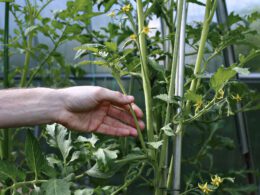You’ve decided to grow your own tomato plants, and as a diligent gardener, you want to ensure they thrive and produce the best possible harvest. To achieve this, it’s essential to provide your plants with the right nutrients at the right time. But with so many feeds on the market, how do you know which one is best for your precious tomatoes?
Fear not! This article will guide you through understanding your tomato plant’s nutritional needs and selecting the perfect feed to keep them healthy and safe throughout their growth stages.
In this comprehensive guide, we’ll explore different types of feeds available for tomato plants and help you tailor each feeding stage according to their specific requirements. We’ll also discuss factors affecting nutrient demands and share some valuable tips on proper feeding techniques and care practices.
By following these guidelines, you can confidently nurture strong, vibrant tomato plants that yield a bountiful harvest while ensuring their safety from harmful elements in lower-quality feeds. So let’s dive in and unlock the secrets to successful tomato plant nourishment!
Understand Your Tomato Plant’s Nutritional Needs
To help your tomatoes thrive, it’s crucial to grasp their nutritional requirements and supply them with the right nourishment.
Tomato plants need three primary nutrients: nitrogen (N), phosphorus (P), and potassium (K). These elements are essential for promoting plant growth, producing flowers and fruits, as well as maintaining overall health. Additionally, tomato plants can benefit from secondary nutrients such as calcium, magnesium, and sulfur.
It’s important to keep in mind that too much of a good thing can be harmful. Over-fertilizing your tomato plants with excessive amounts of any nutrient can lead to poor fruit production or even damage the plant itself. Therefore, you must strike a balance between providing enough nutrients for healthy growth while avoiding over-fertilization.
Regularly testing your soil is an excellent way to ensure you’re providing the proper amount of each nutrient.
As you tend to your tomato plants’ nutritional needs, don’t forget about organic matter like compost or well-rotted manure. Organic materials not only provide valuable nutrients but also improve soil structure by allowing air and water to circulate more freely around plant roots.
A healthy root system enables your tomato plants to absorb nutrients more efficiently and withstand environmental stressors such as drought or disease better than if they were grown in poor soil conditions.
By paying attention to the specific needs of your tomatoes throughout their growing season, you’ll be rewarded with a bountiful harvest!
Types of Tomato Plant Feeds
There’s a variety of nutrient-rich options available when it comes to nourishing those juicy red fruits. Knowing the types of tomato plant feeds can help you choose the best one for your garden, ensuring that your plants grow strong and produce delicious, healthy tomatoes.
In general, there are three main types of feed: organic, synthetic, and homemade compost. Organic feeds are derived from natural sources like bone meal or fish emulsion and can be an excellent choice for those looking to maintain a more eco-friendly garden. These options are safe for both you and the environment while still providing essential nutrients such as nitrogen, phosphorus, potassium, calcium, magnesium, and trace elements needed by your tomato plants.
Synthetic or chemical-based fertilizers offer a faster-acting solution with highly concentrated nutrients that can lead to rapid growth but may come with potential risks to the environment if not used responsibly. Experimenting with homemade compost allows you to utilize kitchen scraps and yard waste in creating a nutrient-dense mixture tailored specifically for your tomato plants’ needs. This method not only saves money but also reduces waste output while being kinder on the environment.
Remember that regardless of which type of feed you choose, it’s important to conduct regular soil tests in order to monitor nutrient levels closely and ensure that your tomato plants receive exactly what they need for optimal fruit production. So go ahead – explore these different feeding options and watch your tomatoes thrive!
Tailoring Feeds for Different Growth Stages
You can optimize your garden’s growth by adjusting the nutrients you provide at each stage of your tomato plants’ development. Providing the right balance of nutrients helps ensure that your plants grow strong, healthy, and produce a bountiful harvest. Different stages of growth require different nutrient ratios to support their specific needs.
-
Seedling stage: At this stage, focus on providing a balanced feed with equal amounts of nitrogen (N), phosphorus (P), and potassium (K). This will help promote healthy root development and overall plant growth.
-
Vegetative stage: As the plant grows taller and develops more leaves, it requires a higher nitrogen content to support foliage growth. Look for a fertilizer with a higher N:P:K ratio, such as 5-3-3.
-
Flowering stage: When flowers start to appear, switch to a lower nitrogen feed and increase phosphorus and potassium levels to encourage fruit production. A suitable ratio would be 4-6-8.
-
Fruiting stage: By now, the focus should be on promoting fruit size and flavor by maintaining high levels of phosphorus and potassium while reducing nitrogen content even further. Opt for a fertilizer with an N:P:K ratio like 2-8-10.
To ensure your tomato plants receive the most appropriate nutrition throughout their lifecycle, monitor their appearance closely for signs that they may need adjustments in their feeding regimen – yellowing leaves could indicate too much or too little nitrogen; weak stems might suggest insufficient phosphorous; small fruits may mean inadequate potassium levels are being provided.
Remember that safety comes first when handling fertilizers – always follow label directions carefully when mixing feeds or applying them directly onto soil or foliage to protect both yourself as well as your treasured tomato plants from harm during these crucial growing stages!
Can the Soil Mixture for Tomatoes be Used as a Feed for Tomato Plants?
Using the best soil mixture for tomatoes as a feed for tomato plants is a smart approach. This unique blend provides the essential nutrients and optimal pH levels, promoting healthy growth and abundant fruit production. With proper care and regular feeding, your tomato plants will thrive and reap delicious rewards.
Factors Affecting Nutrient Requirements
It’s important to understand that various factors can impact your garden’s nutrient requirements, so let’s dive into what these are and how they affect your precious produce. While tomato plants have general nutrient needs, certain factors such as soil type, climate, and plant variety may require adjustments to their feeding regimen. By considering these elements, you’ll provide an optimal environment for growth and ensure a bountiful harvest.
Here’s a quick overview of some key factors affecting nutrient requirements:
| Factor | Impact on Nutrient Requirements |
|---|---|
| Soil Type | Different soils retain nutrients differently; sandy soils may need more frequent feedings while clay soils might require less. |
| Climate | Temperature and humidity can affect the rate at which plants use nutrients; warmer climates may require higher nitrogen levels while cooler climates might benefit from increased phosphorus. |
| Plant Variety | Some tomato varieties grow faster or produce more fruit than others, meaning they could need additional nutrients to support optimal growth. |
By paying attention to these factors when choosing the right feed for your tomato plants, you’re not only promoting healthy growth but also securing a safe and thriving garden space for you and your loved ones. Remember that meeting your tomatoes’ specific nutritional needs is crucial in producing tasty fruits with minimal risk of pests or diseases. So go ahead, take note of these considerations when selecting the best feed for your beloved tomatoes – it will be worth it in the end when you’re enjoying those juicy homegrown fruits!
Tips for Proper Feeding and Care
Nurturing your garden with the right nutrients and care can truly make a world of difference, transforming it into an abundant oasis ripe with delicious bounty. To ensure that your tomato plants are well-fed and cared for, consider these essential tips to help them flourish.
-
Choose the right fertilizer: Opt for a balanced, slow-release fertilizer specifically designed for tomato plants. This will provide a consistent supply of nutrients over time.
-
Monitor soil pH levels: Tomato plants thrive in slightly acidic soil with a pH level between 6.0 and 6.8. Regularly test and adjust the soil’s acidity if needed.
-
Water consistently: Keep your tomato plants’ roots moist but not waterlogged by watering deeply on a regular basis.
-
Mulch around the base: Applying mulch around the base of your tomato plants helps retain moisture, suppress weeds, and regulate soil temperature.
-
Prune selectively: Proper pruning encourages airflow within the plant canopy while promoting fruit production.
Incorporating these strategies into your gardening routine will set you on the path to growing healthy, vibrant tomato plants full of tasty fruits ready for harvest.
Remember that patience is key – tomatoes take time to grow and develop their flavors fully. By providing proper feeding and care throughout each stage of growth, you can reap bountiful rewards from your garden while satisfying that innate desire for safety in nurturing something valuable from seed to harvest.
Conclusion
In conclusion, it’s essential to understand your tomato plant’s nutritional needs and choose the right feed for each growth stage. Keep in mind factors like soil conditions and climate when tailoring your feeding plan.
With proper care and attention to feeding, you’ll be on your way to growing healthy, delicious tomatoes. So go ahead, explore different feeds, experiment with tailored plans, and enjoy the fruits of your labor!









